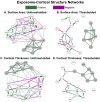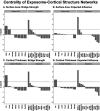This is a preprint.
Multilayer network associations between the exposome and childhood brain development
- PMID: 37961103
- PMCID: PMC10634748
- DOI: 10.1101/2023.10.23.563611
Multilayer network associations between the exposome and childhood brain development
Abstract
Growing up in a high poverty neighborhood is associated with elevated risk for academic challenges and health problems. Here, we take a data-driven approach to exploring how measures of children's environments relate to the development of their brain structure and function in a community sample of children between the ages of 4 and 10 years. We constructed exposomes including measures of family socioeconomic status, children's exposure to adversity, and geocoded measures of neighborhood socioeconomic status, crime, and environmental toxins. We connected the exposome to two structural measures (cortical thickness and surface area, n = 170) and two functional measures (participation coefficient and clustering coefficient, n = 130). We found dense connections within exposome and brain layers and sparse connections between exposome and brain layers. Lower family income was associated with thinner visual cortex, consistent with the theory that accelerated development is detectable in early-developing regions. Greater neighborhood incidence of high blood lead levels was associated with greater segregation of the default mode network, consistent with evidence that toxins are deposited into the brain along the midline. Our study demonstrates the utility of multilayer network analysis to bridge environmental and neural explanatory levels to better understand the complexity of child development.
Figures




Similar articles
-
Associations of Air Pollution on the Brain in Children: A Brain Imaging Study.Res Rep Health Eff Inst. 2022 Feb;2022(209):1-61. Res Rep Health Eff Inst. 2022. PMID: 36106707 Free PMC article.
-
Community and household-level socioeconomic disadvantage and functional organization of the salience and emotion network in children and adolescents.Neuroimage. 2019 Jan 1;184:729-740. doi: 10.1016/j.neuroimage.2018.09.077. Epub 2018 Oct 1. Neuroimage. 2019. PMID: 30287301 Free PMC article.
-
Associations between Neighborhood SES and Functional Brain Network Development.Cereb Cortex. 2020 Jan 10;30(1):1-19. doi: 10.1093/cercor/bhz066. Cereb Cortex. 2020. PMID: 31220218 Free PMC article.
-
Biological aging in childhood and adolescence following experiences of threat and deprivation: A systematic review and meta-analysis.Psychol Bull. 2020 Sep;146(9):721-764. doi: 10.1037/bul0000270. Epub 2020 Aug 3. Psychol Bull. 2020. PMID: 32744840 Free PMC article.
-
Exposome-based public health interventions for infectious diseases in urban settings.Environ Int. 2021 Jan;146:106246. doi: 10.1016/j.envint.2020.106246. Epub 2020 Nov 9. Environ Int. 2021. PMID: 33181410 Free PMC article. Review.
References
-
- Bahrami M., Simpson S.L., Burdette J.H., Lyday R.G., Quandt S.A., Chen H., Arcury T.A., Laurienti P.J., 2022. Altered default mode network associated with pesticide exposure in Latinx children from rural farmworker families. NeuroImage 256, 119179. 10.1016/j.neuroimage.2022.119179 - DOI - PMC - PubMed
-
- Bartolomei F., Bosma I., Klein M., Baayen J.C., Reijneveld J.C., Postma T.J., Heimans J.J., Van Dijk B.W., De Munck J.C., De Jongh A., Cover K.S., Stam C.J., 2006. Disturbed functional connectivity in brain tumour patients: Evaluation by graph analysis of synchronization matrices. Clin. Neurophysiol. 117, 2039–2049. 10.1016/j.clinph.2006.05.018 - DOI - PubMed
Publication types
Grants and funding
LinkOut - more resources
Full Text Sources
